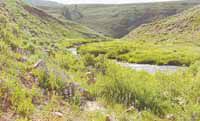| The United States Bureau of Reclamation is expected to release an environmental impact statement in the near future explaining the impact a newly built dam in the Gooseberry-Narrows area would have on the environment. The statement will be open to public comment and could determine the actions taken towards the building of the proposed structure in the area. |
Sanpete’s plan to build a dam in Gooseberry-Narrows area to supply water for agricultural producers in the county has surfaced numerous time only to be delayed.
Since the collapse of the Mammoth Dam in 1917, a second structure to store water has never been constructed in Gooseberry-Narrows. But the United States Bureau of Reclamation (BOR) has competed the federal agency’s environmental impact statement on constructing a dam at the location in question.
In the next month or two, a the new environmental assessment on Sanpete’s proposed water development project will be released to the public for comments. The response to the data compiled in the assessment and the federal agency’s recommended actions could influence the decision about whether the structure should be built.
“Before 1987, Sanpete County had rights to 3,020 acre feet of water that they could and were diverting through a series of tunnels and ditches from the drainage,” explained Carbon Commissioner Bill Krompel.
“In 1987, Carbon water authorities signed an agreement that Sanpete could take another 5,400 acre feet per year. Now, they want to build this dam so they can deliver this extra water,” continued Krompel.
“The only thing is that we have no idea how much they are already taking out of that allotment with their current system because there are few gaging equipment stations on those waterways,” indicated the Carbon commissioner.
Krompel recently submitted a letter to the U.S. Bureau of Reclamation pointing out the problem regarding about how much water is actually being diverted by Sanpete County.
Krompel stated in the letter that, according to documents obtained from the Utah Water Engineer’s Office, he estimated Sanpete County already, in wet and normal years, diverts 26,000 acre feet annually from the Emery-Carbon drainage.
However, Sanpete officials previously responded to a request from the reclamation bureau and estimated that the county diverts only 10,000 acre feet of water from the drainage per year.
“This is a situation where we need to know before anything else is done or a dam is even considered,” emphasized the Carbon County commissioner.
“I am proposing that some money from a recently written BOR grant be used to put in automated gaging stations that can tell everyone exactly how much water is being taken over to the other side of the Wasatch Plateau,” continued Krompel.
While no count of ditches and tunnels that create the present transmountain diversion routes, a 1978 document obtained from the states water engineer shows that the complex consists of 10 ditches, one pipeline and two canals. However that number could be in error because of the 25 years since the list was compiled.
“That’s what I mean,” states Krompel. “No one really knows how much water is going over there.”
According to the Utah Rivers Council there are many reasons that the dam should be built at this site.
First, Sanpete County has not done all it can do to conserve water, particularly when it comes to irrigation canals.
Estimates from the council point out that twice as much water could be gained from the dam if canals were lined. This would prevent seepage loss.
Sanpete County is also becoming more urbanized with homes. Alfalfa is one of the most water thirsty crops grown and new homes are replacing these fields and will not use near the amount of water.
Carbon water users are concerned about water quality. If Scofield Reservoir’s standard level is lowered, chances of water contamination increases. Therefore, the water would require treatment which is higly expensive.
The amount of water that comes down Fish Creek, if decreased, will also affect the fish habitat of the river.
BOR may force some ranchers off turf they have been using for generations to keep the water quality at a high level. These moves would also affect grazing rights around the current Scofield Reservoir.
In terms of cost per acre foot, this dam could be one of the most expensive built. It is estimated the dam would cost taxpayers $17 million.
According to the river council that means each acre foot delivered under the proposal to Sanpete County will cost $3700 per acre foot.
One of the other largest critics of the project is the Sierra Club which is concerned about several endangered fish species as well as “jeopardizing municipal water supplies” in Carbon County.
The environmental assessment that will soon be released will have a 60 day comment period. During that time the public will be able to submit written comments to BOR.

